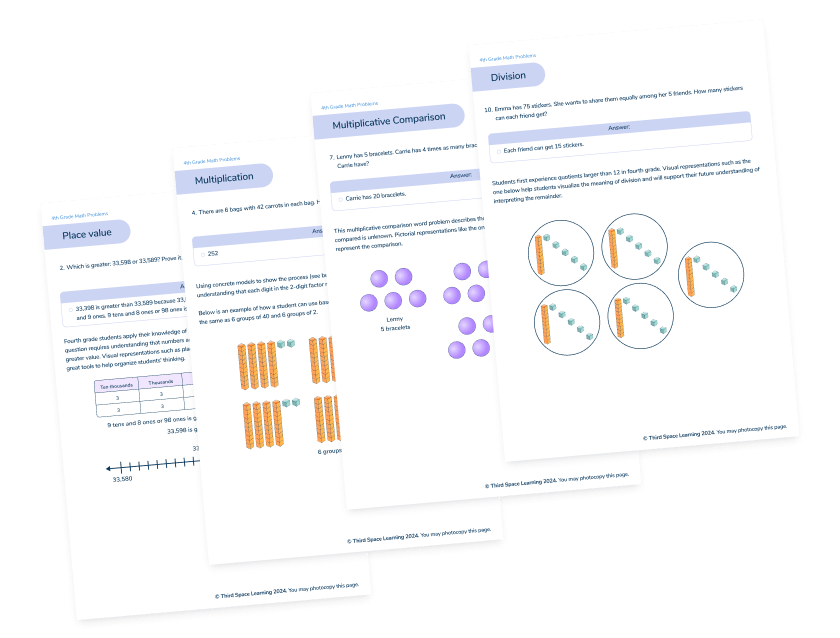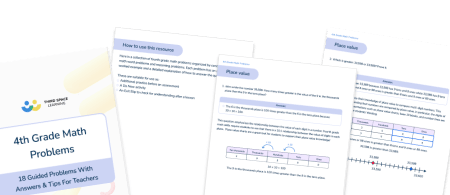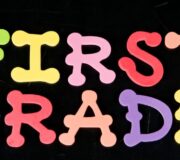4th Grade Math Problems: 18 Guided Problems With Answers & Tips For Teachers
4th grade math problems build on foundational skills of mathematical operations, place value, and the number system. As math content and rigor increase, teachers must understand the skills students need to be successful.
In this blog, we dive into exactly what a fourth grader needs to know in math and provide teachers with math problems, worked examples and tips for teaching.
What are 4th grade math problems?
4th grade math problems are math problems suitable for 9-10 year olds. They include the following math concepts:
- Place value
- Multiplication
- Multiplicative comparison
- Division
- Fractions and decimals
Each math concept is built on the skills students learned in grades K-3. In fourth grade, students are required to use these skills to make sense of math word problems and apply reasoning skills to solve them.
4th grade math curriculum
Fourth grade math demands deep mathematical reasoning using prior grade-level knowledge. In grades K-2, students explore the foundational meaning of the number system and two of its operations: addition and subtraction. Students are exposed to problem solving skills that require reasoning and perseverance.
By third grade, students solidify their understanding of the whole number system and explore new math concepts. Students begin to extend their meaning of whole numbers with the introduction of fractions. In addition, students explore the concept of multiplication and division and how it is related to what they already know about addition and subtraction. All these concepts are explored through hands-on experiences to allow students to discover their own meaning of the math concepts.
In fourth grade, students use their prior knowledge of multiplication, division, and fractions to explore ideas such as:
- Multi-digit multiplication and division
- Division with a remainder
- Adding and subtracting fractions
- Multiplying a fraction by a whole number
- How parts of a whole are related to the decimal system
These concepts are bridged first with concrete math manipulatives, and then pictorial representations following the concrete representational abstract approach.
Fourth grade math skills are a strong base for future math skills. By fifth grade, students are flexible with all four math operations and can use them with various number representations such as whole numbers, fractions including a mixed number, and decimals.
4th grade math misconceptions
A common challenge with teaching fourth grade math is the misconception that instruction and student work must be abstract. It is important to allow students to use manipulatives such as base ten blocks, decimal grids, fraction tiles, and coins to visualize these new math concepts.
The math problems below will illustrate a variety of ways teachers can use these tools to support their learners in showing their thinking.
18 4th Grade Math Problems
18 guided 4th grade math problems covering place value, multiplication, division, fractions and decimals to help students develop their understanding. Complete with answers and explanations.
Download Free Now!4th grade math problems and solutions
Here is a collection of fourth grade math problems organized by concepts, including math word problems and reasoning problems. Each problem has an answer key, a worked example and a detailed explanation of how to answer the question.
Place value
Starting in kindergarten, students are taught that numbers can be decomposed into groups of ten (11 is the same as 10 and 1). Each year, students explore the place value system with greater depth. Fourth grade place value concepts require students to generalize their understanding of place value up to 1,000,000 by reading and writing numbers in different forms, comparing and ordering numbers, and rounding numbers.

Meet Skye, the voice-based AI tutor making math success possible for every student.
Built by teachers and math experts, Skye uses the same pedagogy, curriculum and lesson structure as our traditional tutoring.
But, with more flexibility and a low cost, schools can scale online math tutoring to support every student who needs it.
Find out moreQuestion 1
John wrote the number 39,598. How many times greater is the value of the 9 in the thousands place than the 9 in the tens place?
Answer: The 6 in the thousands place is 100 times greater than the 9 in the tens place because 10 x 10 = 100.
This question emphasizes the relationship between the value of each digit in a number. Fourth grade math skills require students to see that there is a 10:1 relationship between the value of digits in each place. Place value charts are a great tool for students to support their place value knowledge!

Question 2
Which is greater: 33,598 or 33,589? Prove it.
Answer: 33,398 is greater than 33,589 because 33,598 has 9 tens and 8 ones while 33,589 has 8 tens and 9 ones. 9 tens and 8 ones or 98 ones is greater than 8 tens and 9 ones or 89 ones.
Fourth grade students apply their knowledge of place value to compare multi-digit numbers. This question requires understanding that numbers are compared by place value, in particular, the digits of greater value. Visual representations such as place value charts, base 10 blocks, and number lines are great tools to help organize students’ thinking.


Question 3
There were 69,382 fans at a baseball game. About how many fans were at the baseball game? The manager wants to know if the number of fans was closer to 60,000 or closer to 70,000.
Answer: There were about 70,000 fans at the baseball game.
Students continue to explore the concept of rounding, now to any place value. Rounding is key because it allows students to easily talk about numbers. Using a vertical number line is a great tool to help students visualize which benchmark a number is closest to. If students need more support finding the benchmark numbers, provide them with a 1-1000 chart.
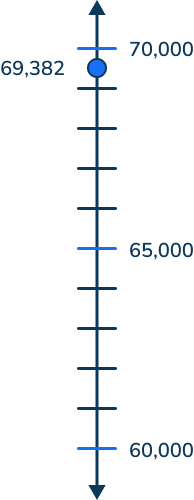
Multiplication
Fourth grade math builds on students’ previous understanding of equal group multiplication to multiplication using the distributive property. It’s important to reintroduce multiplication with concrete manipulatives such as base 10 blocks to show equal groups, or 2-colored counters to show arrays.
As fourth grade students move along the multiplication learning trajectory, they are introduced to other representations of multiplication, such as an area model. These representations rely heavily on place value understanding and basic fact fluency, introduced in 3rd grade. Students who are still struggling with their basic facts may benefit from the use of a multiplication table.
Question 4
There are 6 bags with 42 carrots in each bag. How many carrots are there in all?
Answer: 252
Using concrete models to show the process (see below) helps students develop an important understanding that each digit in the 2-digit factor must be multiplied by the other factor.
Below is an example of how a student can use base-ten blocks to show 6 groups of 42 and see that it is the same as 6 groups of 40 and 6 groups of 2.
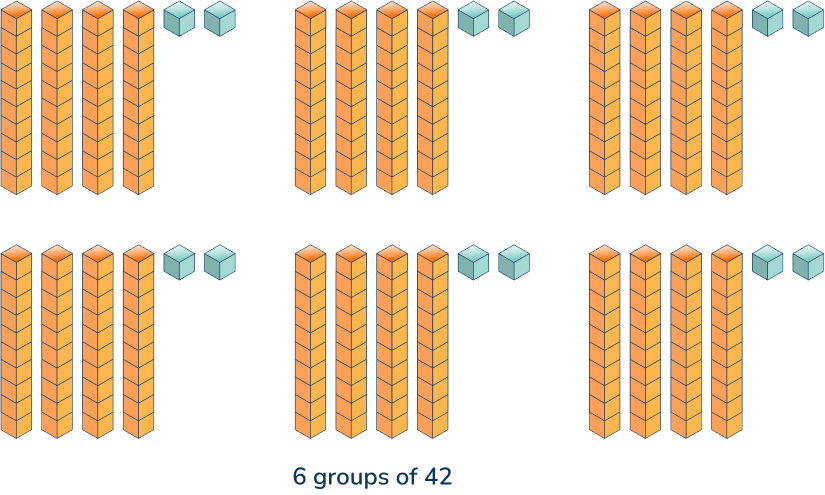
Question 5
West Hill Elementary School is hosting a fifth grade field day. There will be 3 groups of 18 students attending. How many students will be attending fifth grade field day?
Answer: 54
Students then learn that they can multiply 3 × 18 by breaking apart the 18 into 10 + 8 and then multiplying 3 × 10 and 3 × 8 and simply putting the two partial products together to find that 3 × 18 = 54. Graph paper is a great tool to support students’ understanding!

Question 6
Sam organized a 6-mile walk for charity. 128 people completed the walk. How many total miles did the people walk that day?
Answer: 768 miles
Once students understand the area model, they may transition into drawing rectangles to record the partial products. This becomes extremely useful when the factors get larger. It allows students to visualize the process and connect the distributive property to place value concepts.

Multiplicative Comparison
Prior to fourth grade, students experience multiplication as additive thinking, i.e. 4 x 3 = 4 + 4 + 4. Fourth grade math shows students that multiplication can also represent comparisons in which one set or quantity is described in terms of another using multiplicative thinking. Visual representations are a great way to help students bridge the gap between additive and multiplicative thinking.
There are three types of multiplicative comparison word problems:
- When the number being compared is unknown (2 x 4 = n)
- When the number being compared to is unknown (2 x n = 8)
- When the multiplier is unknown (n x 4 = 8)
Check out each problem type with the sample math problems below!
Question 7
Lenny has 5 bracelets. Carrie has 4 times as many bracelets as Lenny. How many bracelets does Carrie have?
Answer: Carrie has 20 bracelets.
This multiplicative comparison word problem describes the first situation type, where the number being compared is unknown. Pictorial representations like the one below help students to visualize and represent the comparison.
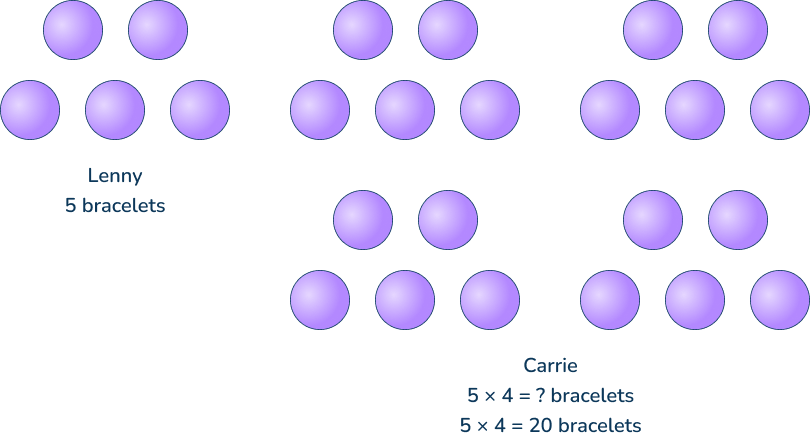
Question 8
Ben and Jeff were playing baseball. Jeff threw the baseball 18 feet which is 3 times farther than Ben did. How far did Ben throw the baseball?
Answer: Ben threw the baseball 6 feet.
Here, students are challenged to find the number that is being compared. The length model below helps to show that either multiplication or division can be used to solve this problem. Recognizing the inverse relationship between multiplication and division can support multiplicative comparison thinking.
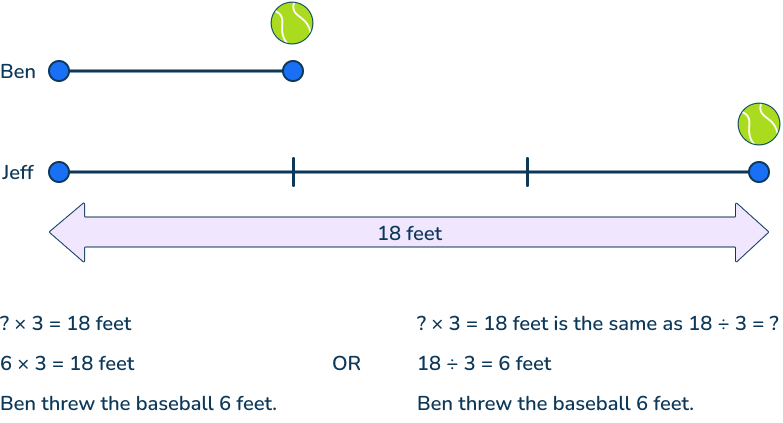
Question 9
Sara spent $32.00 at the school store. Her friend Mikayla spent $8.00. How many times as much money did Sara spend than Mikayla?
Answer: Sara spent 4 times as much as Mikayla at the school store.
Similarly, either multiplication or division can be used for this solution. This math word problem represents when the multiplier is unknown.
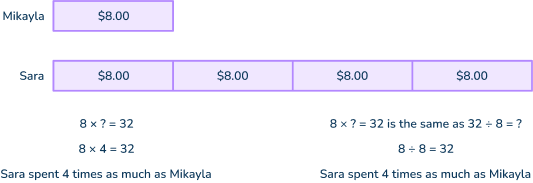
Division
In fourth grade, students extend their understanding of division facts beyond the single-digit facts introduced to in 3rd grade.
Division questions in fourth grade emphasize the use of place value concepts and number relationships. These strategies provide a foundation for introducing the standard algorithm in a few years. Fourth grade math skills also require students to understand the concept of division with remainders. This understanding that sometimes a dividend cannot be divided into even quantities is explored through real-world division word problems.
Question 10
Emma has 75 stickers. She wants to share them equally among her 5 friends. How many stickers can each friend get?
Answer: Each friend can get 15 stickers.
Students first experience quotients larger than 12 in fourth grade. Visual representations such as the one below help students visualize the meaning of division and will support their future understanding of interpreting the remainder.
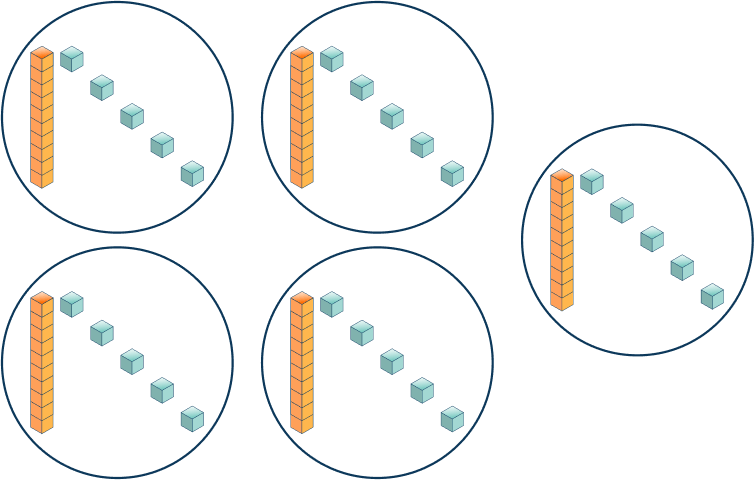
Question 11
Janelle is planning a party. 344 people are coming. Each table seats 8 people. How many tables does Janelle need?
Answer: Janelle needs 43 tables.
Students transition their experiences to using the partial quotients strategy, which is shown below. This strategy highlights the relationship between multiplication and how it’s the inverse of division by determining groups that can be subtracted from the dividend (total) until there are no parts left. This allows for more flexible thinking in finding the quotient.
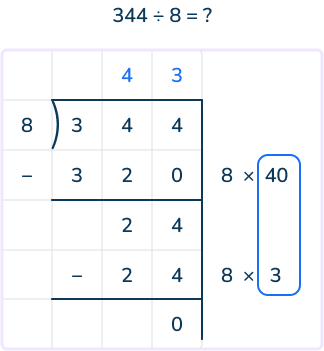
Question 12
Ms. Evans has 125 oranges. 6 oranges can fit in each box. How many boxes does she need for all the oranges?
Answer: Ms. Evans needs 21 boxes.
Fourth grade is the first time students experience division problems where a remainder is left. In this problem, students are tasked with interpreting the remainder based on the context of the problem. Here, students need to understand that the 5 oranges leftover still need to be boxed, so Ms. Evans will need an additional box for those 5 oranges. Each word problem requires the remainder to be interpreted differently so provide opportunities for student discussion and exposure to a variety of word problems.
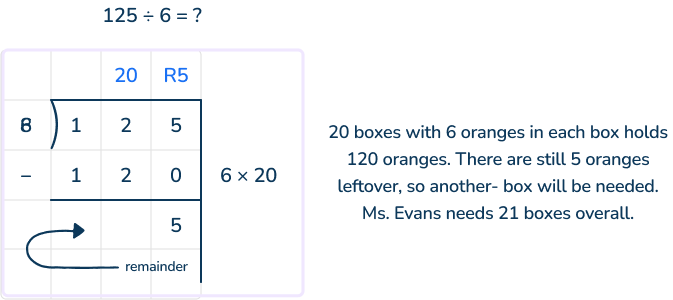
Fractions
Fractions are informally introduced to students as young as first grade. Students are exposed to partitioning shapes into equal parts.
By fourth grade, students begin to apply those foundational fraction concepts to their understanding of operations to add and subtract fractions. To do this, students must understand that a fraction can be decomposed into a sum of fractions with the same denominator, also known as equivalent fractions. In fourth grade, fraction denominators are limited to 2, 3, 4, 6, 8, 10, 12 and 100.
READ MORE: What are equivalent fractions?
In addition, students build on their knowledge of fractions greater than one and are introduced to the academic vocabulary of mixed numbers and improper fractions. Let’s take a look at these three fourth grade fraction concepts in word problems.
Question 13
Cheryl said that \frac{2}{5} and \frac{6}{10} are equivalent fractions. Do you agree or disagree? Prove it.
Answer: \frac{2}{5} and \frac{6}{10} are not equivalent fractions. When finding equivalent fractions, the numerator must be multiplied by the same number as the denominator. In this problem, \frac{2}{5} is partitioned in half to create tenths. This means the numerator and denominator are both multiplied by two. \frac{2}{5} is equivalent to \frac{4}{10} because when you multiply the numerator by 2, you get 4, not 6.
This type of question requires students to understand the concept of equivalent fractions and reasonableness. Estimation is such an important skill because it can support students in the foundational skills of fractions and can be an asset when introduced to addition and subtraction of fractions. Concrete materials such as pattern blocks or fraction strips (as seen below) support students to visualize fractions.
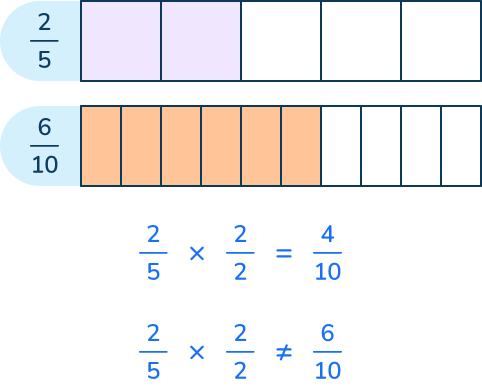
Question 14
Ben ate \frac{2}{4} of a candy bar and shared \frac{1}{4} with his sister. How much of the candy bar did Ben and his sister eat?
Answer: Ben and his sister ate \frac{3}{4} of the candy bar.
As students explore adding fractions, they must link these new concepts to their prior knowledge of adding with whole numbers. For this word problem, a bar model and a number line are great strategies for students to visually see fraction concepts. As students continue to work through their flexibility with whole numbers, they deepen their understanding of operations with fractions.
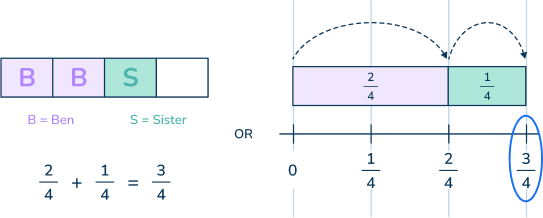
Question 15
At the eighth grade dance at Malcom Middle School, the volunteers served 2 \frac{2}{6} gallons of lemonade and 1 \frac{1}{6} gallons of iced tea. How much more lemonade than iced tea was served?
Answer: 1 \frac{1}{6} more gallons of lemonade were served than iced tea.
Similar to addition, students use their prior knowledge of subtraction and apply it to their new understanding of subtracting fractions.
Students can separate numbers into whole and fractional parts to get the final difference. Again, models such as bar models and number lines are strategies students are exposed to when subtracting whole numbers and are helpful representations to show subtracting fractions.
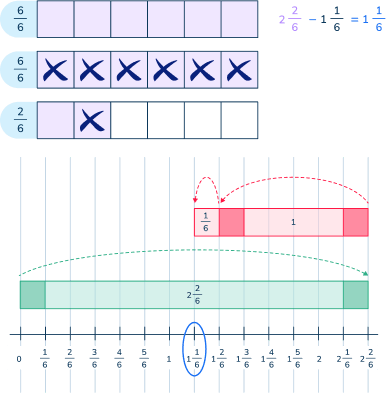
Decimals
Students see decimals everywhere in life: money, measurement, sports, etc.
Fourth grade is when students are formally introduced to decimal notation and their relationship to fractions. Students only explore fractions with denominators 10 and 100 here, so that we can connect it to the relationship between tenths and hundredths. Students’ foundational understanding of fractions and their equivalence helps build the groundwork for exploring decimals to the hundredths.
Question 16
Write each fraction as a decimal: \frac{47}{100}, \frac{5}{10} , 2 \frac{7}{10}, 8 \frac{29}{100}
Answer: \frac{47}{100}, = 0.47, \frac{5}{10} = 0.5, 2 \frac{7}{10} = 2.7, 8 \frac{29}{100} = 8.29
In this problem, students are asked to bridge the concepts of fractions and decimals. Fourth grade math requires students to understand that fractions with denominators based on tens can be written as a decimal.
This understanding relies on a student’s background knowledge of place value relationships. Teachers can connect this idea using the same manipulatives they used to introduce fractions, such as number charts.
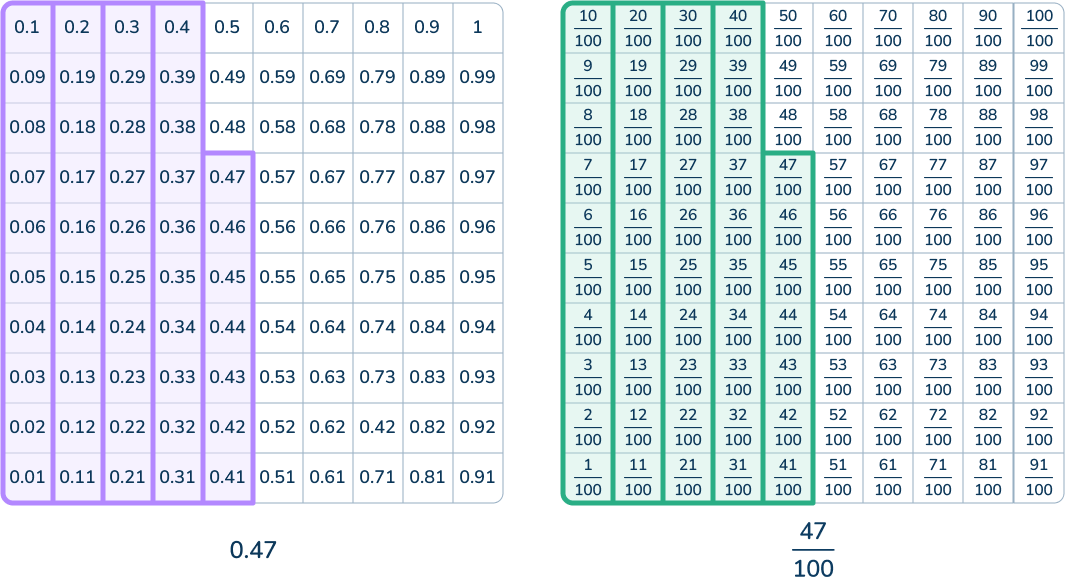
Question 17
Compare the following decimals: 0.65 and 0.46
Answer: 0.65 is greater than 0.46. 0.46 is less than 0.65. Both decimals are less than 1.
Fourth grade math requires students to know the difference between tenths and hundredths. Using models such as number charts and coins help students visualize the concept of comparing decimals and support them in making connections to their whole-number place value knowledge.
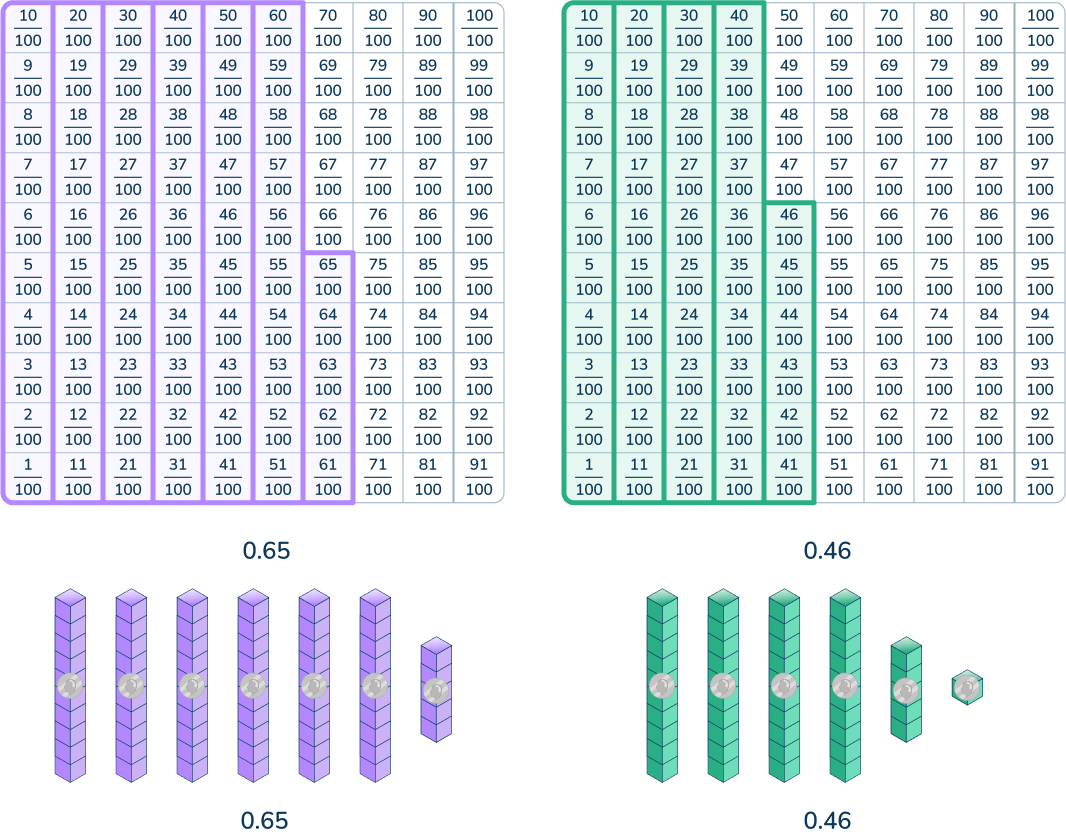
Question 18
Sort the following decimals into the groups below:
0.23 0.99 0.18 0.07 0.73 0.55 0.31 0.64
| Closer to 0 | Closer to 1 |
Answer:
| Closer to 0 | Closer to 1 |
| 0.23 0.18 0.07 0.31 | 0.99 0.73 0.55 0.64 |
This reasoning problem will support students in adding and subtracting decimals in 5th grade.
By using benchmarks such as 0, 0.5, and 1, students can define the magnitude of a decimal in regards to how large/small a tenth or hundredth is. Money is a great tool for this type of problem, as well as a number chart (seen below).
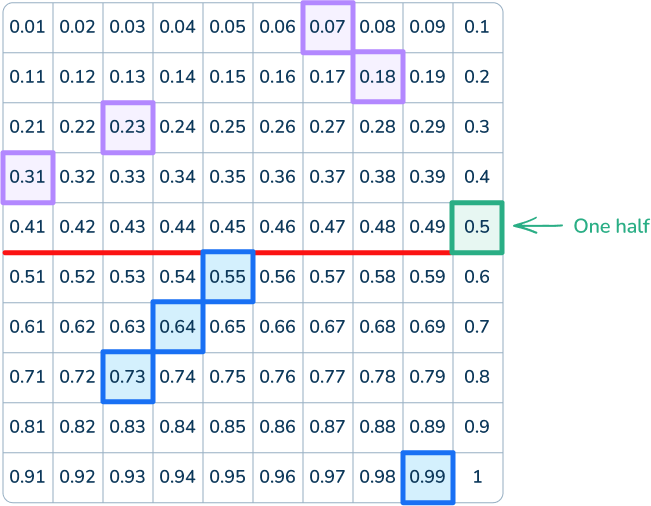
Top tips for teaching 4th grade math problems
When it comes to fourth grade math problems, remember to allow students to explore math concepts in a variety of ways! To support their foundational understanding of math concepts, provide students with multiple representations, such as:
- Concrete models (Base 10 blocks, pattern blocks, fraction strips)
- Pictorial models (area model for multiplication, number lines)
This allows students to discover mathematical connections on their own.
To support students with word problems, use real life math contexts that students can relate to such as recent sports events on TV, topics of interest, etc. Student-driven experiences have the largest impact on student growth and achievement!
How can Third Space Learning help with 4th grade math?
Skye, the AI tutor designed by math teachers, helps close learning gaps and address misconceptions for struggling 4th grade math students. AI math tutoring sessions help students deepen their understanding of the math curriculum and keep up with difficult math concepts.
Each student works with Skye one-on-one. Skye adapts instruction and math lesson content in real-time according to the student’s needs to accelerate learning.
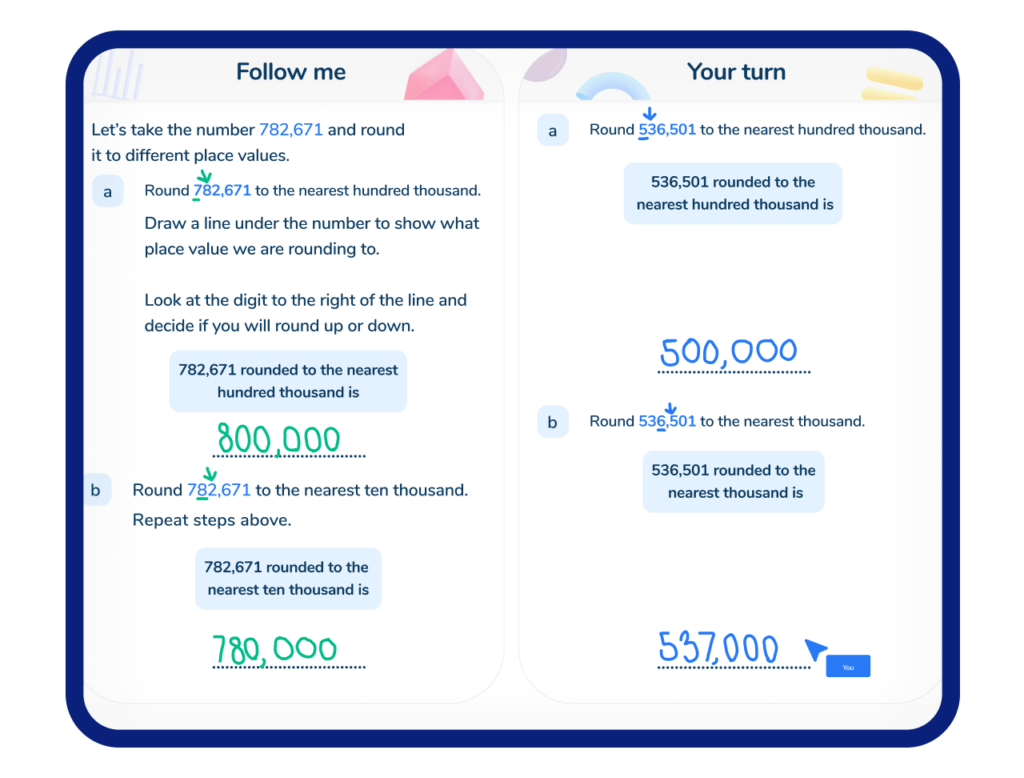
4th grade math problems: Worksheets and printables
Looking for more resources? Please see our 4th grade math test and selection of fourth grade math worksheets covering 4th grade key topics and more:
- Teaching Long Division Worksheets
- Teaching Long Multiplication
- Ordering Fractions Worksheet
- Multi-digit Multiplication Numbers Worksheet
- Dividing Multi-digit Numbers Worksheet
- Adding and Subtracting Decimals Worksheets
4th grade math problems FAQs
Frequently asked questions
What math should a 4th grader know?
Fourth grade math should focus on three main areas: (1) multi-digit multiplication and division (2) fraction concepts including equivalence, addition with like denominators and subtraction of fractions by whole numbers (3) understand that shapes can be classified by properties such as parallel lines, symmetry, angle measurements, etc. Focus on these three math concepts and your students will be successful fourth graders!
What is a 4th grade math problem?
Fourth grade math is all about connecting and extending a student’s past math experiences. In grades K-3, students have explored the whole number system all the way to the thousands place, explored the four math operations, and started to look at what numbers less than one look like. Now, as a fourth grader, students build on that knowledge by looking at numbers all the way to the millions, take a deeper dive into the four math operations up to the millions, and explore how numbers less than one can be written in different forms such as fractions and decimals.
Is 4th grade math hard?
Fourth grade math is not hard! It’s all about relationships: How are whole numbers similar to fractions? How does adding whole numbers relate to adding fractions with like denominators? Fourth grade math makes a lot of connections to what students might see as “easy math”. Make sure to highlight those prior connections in order to make new ones!
Do you have students who need extra support in math?
Skye—our AI math tutor built by experienced teachers—provides students with personalized one-on-one, spoken instruction that helps them master concepts, close skill gaps, and gain confidence.
Since 2013, we’ve delivered over 2 million hours of math lessons to more than 170,000 students, guiding them toward higher math achievement.
Discover how our AI math tutoring can boost student success, or see how our math programs can support your school’s goals:
– 3rd grade tutoring
– 4th grade tutoring
– 5th grade tutoring
– 6th grade tutoring
– 7th grade tutoring
– 8th grade tutoring
